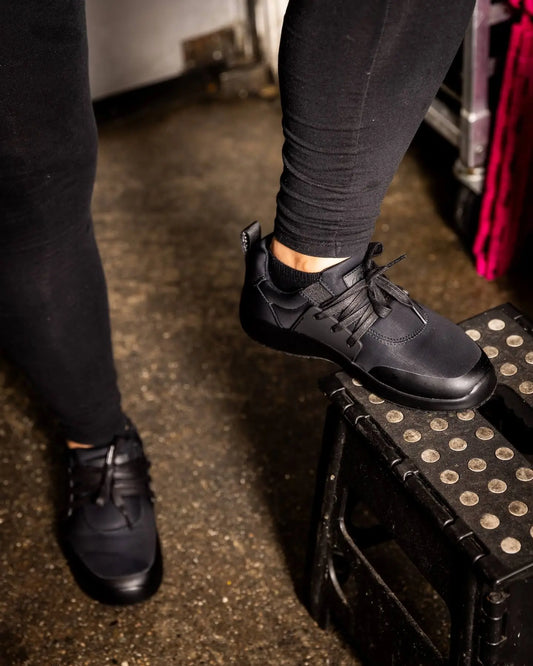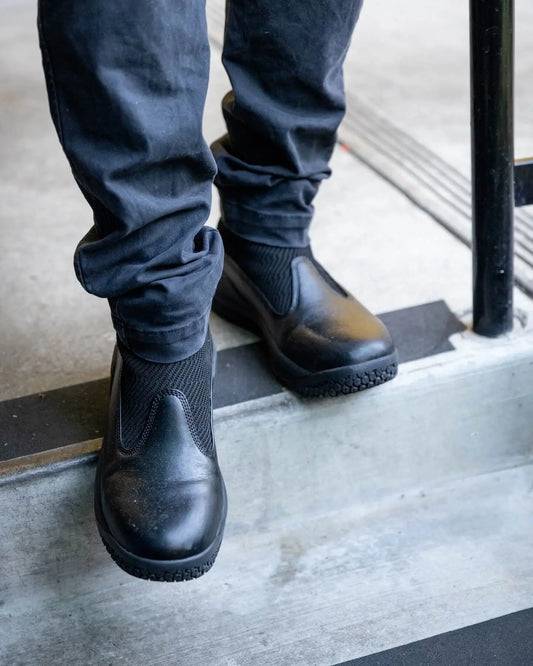Work Exercises for Chefs
Alex Kinejara
From chopping vegetables to running between the freezer and the line, chefs and kitchen staff often expend a lot of energy doing their jobs. AsKitchen accidents a result, aches and pains can be quite common among restaurant workers. Kitchen accidents can happen when you’re not in the best shape. Certain kitchen hazards, like material handling injuries, can happen. Whether you are an executive chef, professional chef, student chef, pastry chef or waiter, everyone can benefit from regular exercise and adding extra physical activity daily.
Fortunately, you can help relieve achy joints and muscles by exercising at work. That way, you can perfect your latest dish while strengthening your core.
If you’re a chef, server, or kitchen staff member, read on to learn five exercises for chefs that can help you maintain your health as well as the best kitchen shoes to help you navigate the hustle and bustle of restaurant life.
#1 Cardio
It may not seem like it, given the small size of many restaurant kitchens, but chefs and kitchen staff move around a lot. All that moving around can be quite a workout. Some chefs and restaurant staff may walk several miles a day from the freezer to the line. They may even have to make multiple trips to their restaurant’s office.
As a result, high cardio levels can be just as beneficial as sharp knives. The last thing you want is to prepare a delicious dish only to feel winded as you apply that final touch of parsley.
Cardio is great for the heart muscle and lungs. Furthermore, the benefits of cardio can extend further than respiration. Many studies reveal that cardio can lower your blood pressure.1 Because restaurant work can be very stressful, cardio can help chefs lower their blood pressure during stressful situations. Weight loss is another benefit of doing an at-work workout routine.
Here’s how to get your cardio in while donning your apron:
While performing cardio in your restaurant can come with many benefits, you should be careful not to slip. After all, water and grease can be mainstays of restaurant kitchens—especially during busy hours. In fact, slip and fall injuries are one of the most common chef injuries.
As a result, it’s best to do cardio exercises in non-slip shoes that feature water resistance and all-day comfort.
#2 Foot Push-Ups
Foot push-ups, also known as heel raises, can help strengthen your feet while reducing inflammation. Foot push-ups can also help reduce the symptoms of plantar fasciitis.2
In short, plantar fasciitis largely affects people who spend large amounts of time on their feet. As a result, chefs may be especially prone to this condition. Symptoms include heel pain and abnormal tissue growth.3
The good news is that you can perform foot push-ups almost anywhere in the kitchen. Here’s how to perfect your foot push-up:
- Stand upright in front of a counter in your kitchen. The counter should be clean and free of knives, cutting boards, produce, and any other restaurant equipment. Place both of your palms on the counter.
- Place all of your weight on the heels of your feet. Slowly lift your toes until they’re as high as they can go. Then, lower your toes until they’re flat on the floor. Repeat this movement 15 to 20 reps.
- Next, shift your weight to your toes. Slowly lift your heels until you’re almost standing on your toes. Then, lower your heels until they’re flat on the floor. Repeat this movement 15 to 20 reps.
- Take a break and repeat another set. If you’re busy, perform sets throughout the day.
Although simple, foot push-ups can help strengthen and stretch the muscles in your feet. Several sets of foot push-ups can be the difference between your feet cramping while cracking a few eggs and remaining loose as you knock out another soufflé.
#3 Calf Stretches
Your calf muscles are located at the backs of your legs and provide support, stability, balance, and movement. Consequently, calf exercises are crucial for chefs. Properly stretching and strengthening your calf muscles can lessen the impacts of spending a lot of time on your feet, such as:4
- Pain and swelling
- Tenderness
- Tightness in your calves
When the kitchen is busy, stiff calves may prevent you from catching an incomplete dish before it heads out the kitchen.
Here’s how to master your calf stretches:
- Stand in front of a wall. Make sure the wall is free of knives and cookware. (Ideally, you should also make sure that the wall is out of view of the dining room.) Place both of your hands firmly on the wall.
- Place one leg in front of the other. Bend your front leg at the knee while keeping your back leg straight.
- Gently press against the wall, allowing your back calf to stretch. Hold this position for thirty seconds. Relax and repeat two to three times. Then, switch your legs, so your back leg is your front leg. Again, hold this position for thirty seconds and repeat.
#4 Shoulder Shrugs
So far, we’ve discussed exercises that strengthen and stretch your lower body. However, you’ll also want to perform exercises that stretch your upper body. That’s because restaurant work often means hunching over menus, dishes, and paperwork.
By targeting your trapezius muscles, shoulder shrugs can help you stretch out your shoulders and neck. By doing so, shoulder shrugs can help alleviate:5
- Poor posture
- Weak shoulders
- Stiff neck
- Tension in your back
Like foot push-ups and calf stretches, shoulder shrugs are incredibly easy to do anywhere in a restaurant. Here’s how to perform them:
- Stand on a flat surface with your back upright. Spread your feet until they are shoulder-width apart.
- Place your arms at your sides and turn your palms inward. You can also do this exercise with weights. If you use weights and don’t have spare dumbbells lying around, you might be able to pick up heavy restaurant equipment.
- Bend your knees slightly and look straight ahead. Be sure to keep your neck straight and aligned with the rest of your body.
- Breathe in and lift your shoulders as high as you can. Pretend like your shoulders can touch your ears. Don’t rush this movement. You want to shrug slowly to utilize all of your shoulder muscles.
- Breathe out as you lower your shoulders. Repeat this movement at least ten times. Aim for two to three sets.
#5 Wall Squats
Wall squats can be one of the most strenuous exercises you can do in your restaurant. They can also be one of the most helpful. Wall squats can benefit you in the following ways:6
Here’s how to perform wall squats:
- Press your back firmly against a wall. Move your feet outwards a few inches. Spread your feet until they’re shoulder-width apart.
- Lower yourself down the wall until you’re “sitting” against it. In other words, your thighs should be parallel to the floor.
- Keep your head against the wall and your back straight. Keep your arms by your side. Hold this position for thirty seconds.
- Stand up and stretch. Then, perform several more sets.
Although they can be extremely beneficial, wall squats, like cardio, can come with a few risks. For starters, make sure that the floor beneath you isn’t wet. Also, only perform this exercise once you’ve properly stretched.
Finally, wear the proper footwear when engaging in this movement. In addition to non-slip shoes, you’ll want to wear compression socks that can enable proper blood flow and oxygen. That way, you can perform this exercise safely before returning to the kitchen line.
Get Comfortable on Your Feet with Snibbs
While a lot of chef work depends on your hands, your feet also play a crucial role in your culinary creations. After all, what good is your knife work if your feet are too tired to reach the cutting board? Luckily, Snibbs slip-resistant work shoes can help you stay comfortable on your feet.
Our footwear is designed by industry veterans for industry professionals. As a result, our shoes and socks merge functionality with aesthetics, providing comfort, stability, traction, and cool vibes.
Whether you’re moving between tables greeting guests or running between the freezer and the dish area, Snibbs can help you feel your best in the kitchen and beyond.
Sources:
- Frontiers in Cardiovascular Medicine. Cardiovascular Effects and Benefits of Exercise. https://www.ncbi.nlm.nih.gov/pmc/articles/PMC6172294/#:~:text=Frequent%20exercise%20is%20robustly%20associated,more%20favorable%20plasma%20lipoprotein%20profile.
- Foot Pain Explored. Plantar Fasciitis Exercises. https://www.foot-pain-explored.com/plantar-fasciitis-exercises.html
- American Family Physician. Plantar Fasciitis. https://pubmed.ncbi.nlm.nih.gov/31194492/
- Healthline. Stretches and Treatment for Tight Calves. https://www.healthline.com/health/tight-calves
- Healthline. Benefits of Shoulder Shrugs and How to Do Them. https://www.healthline.com/health/fitness-exercise/shoulder-shrugs#muscles-worked
- MasterClass. Wall Squat Exercise Guide: How to Master Wall Squats. https://www.masterclass.com/articles/wall-squat-guide














